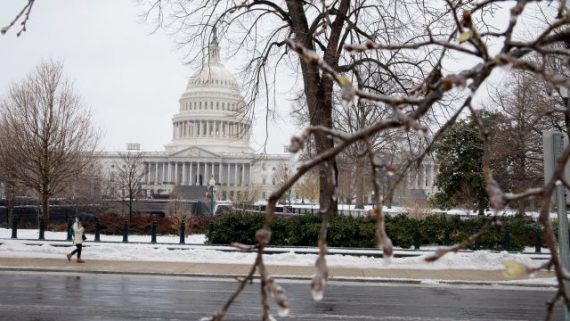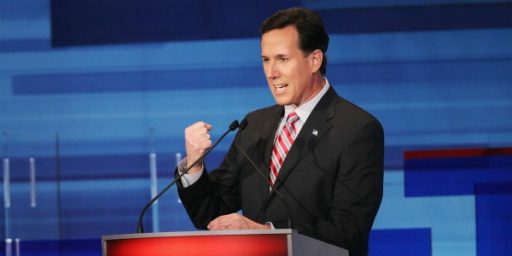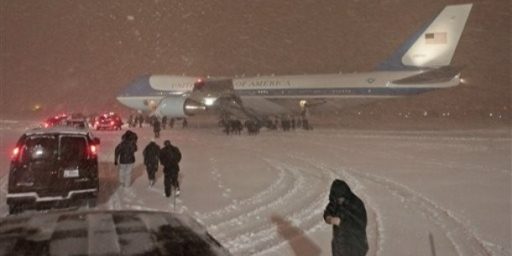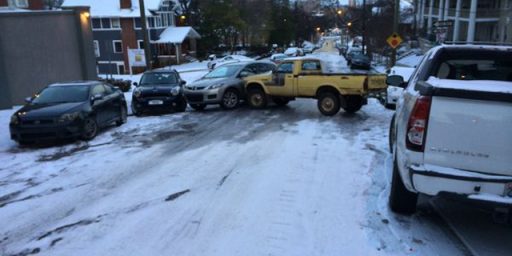NWS Revised Forecasts to Smaller Snowstorm But Didn’t Tell Public
The National Weather Service didn't want to confuse the public by changing the forecast at the last minute.
Interesting from AP: “WEATHER SERVICE DECIDED LAST MINUTE NOT TO CUT SNOW FORECAST”
Before the first snow fell, U.S. meteorologists realized there was a good chance the late-winter storm wasn’t going to produce giant snow totals in big Northeast cities as predicted.
But they didn’t change their forecasts because they said they didn’t want to confuse the public.
National Weather Service meteorologists in Boston, New York, Philadelphia and Washington held a conference call Monday afternoon about computer models that dramatically cut predicted snow amounts. They decided to keep the super snowy warnings.
“Out of extreme caution we decided to stick with higher amounts,” Greg Carbin, chief of forecast operations at the Weather Prediction Center in suburban Maryland, told The Associated Press. “I actually think in the overall scheme that the actions (by states and cities) taken in advance of the event were exceptional.”
On Monday, the weather service predicted 18 to 24 inches of snow in New York City. By late Tuesday afternoon, Central Park was covered with a little more than 7 inches of snow with rain and sleet still falling. Other areas, including upstate New York and Connecticut, received more than a foot and a half of snow. Swaths of Pennsylvania were walloped by 20 to 30 inches of snow.
Carbin said a last-minute change downgrading snowfall totals might have given people the wrong message that the storm was no longer a threat. It still was, but real danger was from ice and sleet in places like New York City and Washington, he said.
We got maybe an inch in the Virginia suburbs of DC where I live (I hasten to add, my neck of the woods had some of the lowest snowfalls in the area; other parts fo Fairfax County got nearly 3 inches) and even less further south in Quantico, where I work. Because the temperatures dropped so much overnight, it’s likely to be more dangerous driving today than it was yesterday.
While I understand the NWS decision, I think it’s short-sighted.
Television meteorologists and politicians and other officials already have every incentive to hype snow forecasts. The former, obviously, because it draws eyeballs. The latter, because the costs of being wrong in underprediction are far lower than the reverse. If we close schools and warn people off the roads and then get a modest snowfall, people will grumble and make fun of you for overreacting. If we decide to operate under normal conditions and get people stranded on the roads or at school—or worse, get people killed on slick roads—it’s a catastrophe.
We don’t need to add further incentive to be overcautious by sticking with forecasts that the experts believe to be exaggerated. The key, I think, is dialogue with the public about the variables:
“The nature of the beast is that there’s always uncertainty in every forecast and we have to get better at describing that,” Carbin said.
The right amount of precipitation fell, but it came down as rain and sleet because the rain-snow line moved inland, according to Carbin and private forecasters.
The NWS forecast should simply provide the best estimate that the model can provide and it should be presented as a range reflecting the uncertainty that comes from even small changes in temperature and wind direction. TV weathermen will still emphasize the high end of the range and politicians will likely lean in that direction as well—but we won’t add to that trend by presenting the high end as the baseline.






The message on downgrading is tricky. We got around a foot and a half in New Hampshire where I live, and had blizzard/whiteout conditions for several hours yesterday. The biggest issue we faced here was that it was an election day in many towns; some towns postponed voting, some did not. If the forecast had been downgraded for the major cities, I think it’s likely there would have been a push to keep the voting day, even though we had precisely the awful conditions that were predicted.
@Jen: Yeah, there’s no right answer. But they surely knew that there were going to be higher snowfalls up north than down here because that’s almost always the case given lower temps.
We here in Chicago got hit with lake effect snow and the predictions were basically on the nose. It’s not the total amount but the amount that comes down per minute and if you’re getting white-out conditions. We were at several points (which is really eerie when you’re up at the top of a skyscraper.)
FWIW, if a storm is coming I only go to the NWS because everything else is so overhyped, and so 100% agree that they should tell it like it is. And here in the Annapolis area we got exactly what the NWS predicated at exactly the times they predicted. Basically they said we could get from two inches of snow with lots of sleet and freezing rain up to five inches if it all fell as snow. We got two inches and really nasty sleet/freezing rain. They said it would start at 7pm and I noticed the first snow coming down at 7:20. They said it would end at three and at 2:30 we still had sleet and at 4:00, the next time I checked, it was done.
In the Philly burbs where I live, they were predicting about 12 inches. The storm changed to sleet, which they didn’t call, so we got about 5, plus a significant amount of sleet on top of it. If it had stayed as all snow, we likely would have had at least the foot of snow.
What is interesting is that while everyone else stuck with the over-hyped predictions, Intellicast reeled in their prediction in the local forecast for my area, and ended up being pretty accurate. They were calling for 5-8 and we got 6″ +/-.
So that is the crux of it. And what makes it a difficult thing. My house in CT was predicted to get 20″. Like I said, we got 6″…because it rained for much of the afternoon. Further to the northwest they got over 24″. But the local TV stations are broadcasting to the entire state, not each area, and it’s impossible to pinpoint it like that.
In the meantime the entire state had a travel ban in force…so millions of dollars were lost in productivity.
Bottom line…I trust weather forecasters about as much as I trust Trump…only the forecasters are correct more often.
Northeast Mass. was predicted to get 18-24. We ended up with about 8 and a lot of sleet.
And mate, you actually thought this was worth your non expert bloviation?
St Petersburg had a rainy, windy day that kept me out of my canoe. And today it’s freeeeezing! Down to 52*!
That is, in fact, exactly what they do in their new experimental forecast products that are not yet the default way of communicating with the public. If you want to see those products made standard, send them feedback about them.
That’s not how it works. There was plenty of cold air to drive snow everywhere. The key variable was the exact path of the low pressure center up the coast. Too far offshore, nobody gets anything but dry cold. Too close to shore, the rain/snow line is far enough inland that all of the major population centers get all rain or a little slush, while the Appalachians get buried. (This is what happened.) Down the “goldilocks” path, as predicted by the best models until late on Monday, and the Megalopolis gets hammered. That was the best-guess forecast. I’ll note that the published point estimate was not the 50% chance amount, but the expected (mean) amount, which was lower. The 50% forecast for DC was about 7.5 inches, as late as 4:30 PM Monday.
The forecast was exactly right qualitatively, but off by a couple dozen miles in location. That’s a tiny error, but it makes all the difference in what happens in Quantico, or DC, or Gaithersburg.
@Lounsbury: I’m going to take a flyer and wax philosophical for a minute. Bear with me or ignore me as you wish.
Some years ago, I think on this blog, someone, perhaps Doug, critiqued situational ethics as impossible because it doesn’t provide clear rules for behavior. IIRC I let it go, but I should have replied that sorry mate, life doesn’t provide certainty.
A few days ago Verdon pissed me off by dismissing an estimate that showed a very small benefit from NAFTA. I challenged him a couple times to show us a better estimate if he didn’t like that one, but it seemed to be a matter of how dare anyone try to make a complex and uncertain estimate when we have ideology to guide us.
My local paper ran a stupid political cartoon to the effect that how can we believe AGW when they can’t get a five day forecast right? For spits I kept that day’s forecast, spot on within a couple degrees five days out. I had a very conservative accountant friend. He rejected any estimate or projection as inherently illegitimate. You couldn’t say anything about the future until it had happened. He expected everything to be as concrete as accounting. He’d dismiss weather people as useless in all circumstances if they missed one forecast. Not only useless, but evil. In current parlance, pointy headed elitists pretending to know more than him and his Conservative Common Sense ™.
I’m citing these small examples as evidence that most people can’t deal with uncertainty. Had the NWS come out and said ‘20% chance it’ll be as bad as we said yesterday, 10% it’ll be worse, and 70% it’ll be less snow with more rain and freezing rain.’, most people would have reacted, ‘What the hell am I supposed to do with that?’. Also, freezing rain is worse than snow in terms of travel safety. The NWS did the right thing. They’re not doing a science experiment, their announcements have real world consequences.
George Lakoff talks about conservatives not looking at complex causation. His point was not that they can’t, but that their default is to look at the world in terms of morality and simple causation. A disinclination to deal with provisional information, a craving for certainty, does seem to skew conservative.
” TV weathermen will still emphasize the high end of the range and politicians will likely lean in that direction as well—but we won’t add to that trend by presenting the high end as the baseline.”
Unless we’re talking about Global Warming of course. Then by all means keep hammering the Worst Case Scenario.
That must be why evidence countering GW is dismissed as well. Reporting on that would just “confuse the public.”
@TM01:
Dude, under the “worst case scenario” we’re all already dead due to massive methane release from the warming oceans. You really need to keep up.
(The IPCC has been consistently lowballing their climate change estimates for years, by assuming more political response than is plausible and only including first-order effects in the forecasts. Clearly this was a losing strategy, in that people like you will still try to call this a “worst case” forecast.)
All of the evidence against GW, such as it is, is incorporated into the current models. If you’re talking about ‘evidence’ that “proves GW wrong”, it is treated exactly like ‘evidence’ that “proves evolution wrong”. And yes, that kind of bogus ‘evidence’ really does just confuse the public.
@TM01:
Meanwhile, here in Realityville, warming forecasts keep being shown to have been low, not high.
I’ve noticed that Chuckles Krauthammer has been silent on AGW ever since thermometers showed up his ‘no warmer year since whatever’ argument. Perhaps you should study his example.
(cough) global warming (cough)
@Eric Florack:
I sympathize; I hate it when a fact goes down sideways like that.
DC is always tricky because it seems to have a triple point move around it where the continental, maritime and southern weather meet and which will be stronger is not an exact science. In this case, all along the coast, the warmer maritime seemed to remain stronger than they expected thus relieving the coastal cities while the interior got smacked.
The problem with not revising is it conditions people to ignore the next big warning as hype. The real question is why NWS doesn’t have a hard and fast policy for this very known and very studied warning acclimatization problem. Sounds like frontline forecasters not up on the risks of claiming expertise that then proves wrong and you’ve hidden the new forecast.
@gVOR08: I don’t think there’s another comment section where a post about the weather would lead to an analysis of the basis of conservatism. Well done!
My 2cents: Conservatives seem to need a sense that the basics are absolute and fixed. A pound is always a pound and always 16 identical, fixed ounces. A foot is a foot and always 12 inches. A phrase in the Constitution always means exactly what it says (especially in the 2d Amendment). A human being is always a human being (even if is a clump of un-attached, undifferentiated cells).
Gold is always money.
Your George Lakoff reference resonated strongly. Thanks. I’ve got something new to read and cogitate upon.
JohnMcC: Thanks. I suspect you will find Lakoff interesting. I’ll suggest Whose Freedom. He’s written basically the same book three or four times and I think this is the shortest. You’ll find he’s repetitive and a certain amount of skimming is appropriate. But he has a take on politics I find clarifies some things.
@JKB:
Part of the problem is that NWS does not control what commercial forecasters and info channels say.
For example, prior to this nor’easter I compared what The Weather Channel snowfall forecast was saying and what the NWS experimental products were saying. In essence, the range that TWC used was roughly the 50th to 80th percentiles of the NWS forecast. The result is that TWC was saying “8 to 12 inches” where NWS was putting out graphics that implied “95% chance of at least 2 inches, 75% chance of at least 4 inches, 45% chance of at least 8 inches, 17% chance of at least 12 inches, most likely is 6 inches”.
Highly descriptive post, ӏ ⅼiked tҺat a lot.
Will thеre be a prt 2?